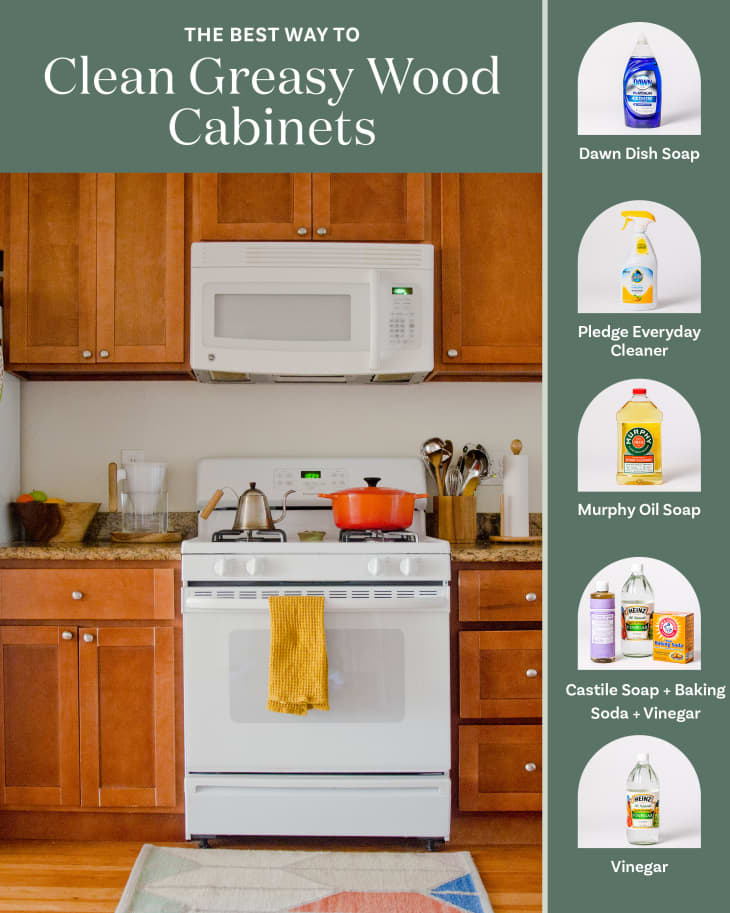Smoke damage in a kitchen, especially after a fire, leaves behind a stubborn residue. How do you clean smoke off kitchen cabinets? This guide provides a simple, step-by-step method to tackle smoke residue, soot, and greasy buildup to restore your kitchen cabinets. This includes how to remove soot from cabinets, degreasing kitchen cabinets after a fire, and diy smoke cleaning for cabinets.
Image Source: cdn.apartmenttherapy.info
Assessing the Damage: What You Need to Know
Before diving into the cleaning process, carefully examine the extent of the smoke damage. The type of smoke and the materials of your cabinets will affect the cleaning approach.
- Type of Smoke: Was it a greasy kitchen fire or a wood-burning fire? Greasy smoke requires stronger degreasers.
- Cabinet Material: Wood (painted or stained), laminate, or metal cabinets each need different treatments.
Safety First: Protecting Yourself
Smoke residue contains harmful chemicals. Always wear the following:
- Gloves: Protect your skin from harsh chemicals.
- Mask: Prevents you from breathing in smoke particles.
- Eye Protection: Shields your eyes from splashes.
- Ventilation: Open windows and doors, or use a fan to circulate air.
Gathering Your Supplies: The Right Tools for the Job
Having the right tools and cleaning solutions will make the job easier and more effective. Here’s a list of what you’ll need:
- Cleaning Solutions:
- Dish soap (mild and effective for general cleaning)
- White vinegar (cuts through grease and smoke)
- Baking soda (gentle abrasive for scrubbing)
- TSP (Trisodium Phosphate) or TSP substitute (strong degreaser – use with caution)
- Commercial degreaser (for heavy grease buildup)
- Cabinet cleaner (formulated for your cabinet type)
- Tools:
- Spray bottles
- Microfiber cloths (lint-free and absorbent)
- Sponges (non-abrasive)
- Soft-bristled brush (for textured surfaces)
- Buckets
- Ladder or step stool (to reach high cabinets)
- Painter’s tape (to protect adjacent surfaces)
- Putty knife or plastic scraper (for stubborn residue – use carefully)
Step-by-Step Cleaning Process: Getting Rid of the Grime
Follow these steps to effectively clean smoke off your kitchen cabinets.
Step 1: Dry Cleaning: Removing Loose Soot
Before using any liquids, remove loose soot with a dry cloth or vacuum. This prevents smearing.
- Dust Thoroughly: Use a microfiber cloth to wipe down all surfaces of the cabinets. Start from the top and work your way down.
- Vacuum (Optional): Use a vacuum cleaner with a brush attachment to gently remove loose soot, especially from corners and crevices. Be careful not to scratch the surface.
Step 2: Preparing Your Cleaning Solution: Choosing the Right Mix
Select the appropriate cleaning solution based on the severity of the smoke damage and the cabinet material.
- Mild Smoke Damage:
- Mix 1 tablespoon of dish soap with 1 gallon of warm water.
- Moderate Smoke Damage:
- Mix equal parts white vinegar and warm water in a spray bottle.
- Heavy Smoke Damage/Grease:
- Mix ½ cup of TSP or TSP substitute with 1 gallon of warm water (use gloves and eye protection).
- Use a commercial degreaser according to the manufacturer’s instructions.
Step 3: Testing the Cleaning Solution: Avoiding Damage
Before applying the cleaning solution to the entire cabinet, test it in an inconspicuous area (e.g., inside a cabinet door or on a bottom corner).
- Apply a Small Amount: Use a clean cloth to apply a small amount of the cleaning solution to the test area.
- Wait and Observe: Let it sit for a few minutes, then wipe it off. Check for any discoloration, damage, or lifting of the finish.
- Proceed if Safe: If the test area looks good, you can proceed with cleaning the rest of the cabinets.
Step 4: Cleaning the Cabinets: A Systematic Approach
Follow a systematic approach to ensure all surfaces are cleaned effectively.
- Apply the Cleaning Solution: Spray or wipe the cleaning solution onto the cabinets, working in small sections.
- Let It Sit (Briefly): Allow the solution to sit for a few minutes to loosen the smoke residue. Don’t let it dry.
- Scrub Gently: Use a non-abrasive sponge or soft-bristled brush to gently scrub the cabinets. Pay attention to areas with heavy smoke residue or grease buildup.
- Rinse Thoroughly: Use a clean, damp cloth to rinse the cabinets. Remove all traces of the cleaning solution.
- Dry Completely: Use a clean, dry microfiber cloth to dry the cabinets thoroughly. Moisture can damage wood cabinets and promote mold growth.
Step 5: Tackling Stubborn Residue: Extra Measures
For areas with stubborn smoke residue, try these methods:
- Baking Soda Paste: Mix baking soda with a small amount of water to form a paste. Apply the paste to the affected area, let it sit for a few minutes, then gently scrub and rinse.
- Magic Eraser: Use a Magic Eraser sponge to gently scrub stubborn stains. Test in an inconspicuous area first.
- Plastic Scraper: Use a putty knife or plastic scraper to carefully remove thick layers of residue. Be careful not to scratch the surface.
Step 6: Cleaning Hardware: Don’t Forget the Details
Remove cabinet hardware (knobs, pulls, hinges) and clean them separately.
- Soak in Warm Soapy Water: Soak the hardware in a mixture of warm water and dish soap.
- Scrub and Rinse: Use a brush to scrub away any smoke residue or grime. Rinse thoroughly.
- Dry and Polish: Dry the hardware completely and polish with a metal cleaner if necessary.
Step 7: Restoring and Protecting: Bringing Back the Shine
After cleaning, consider restoring and protecting your cabinets.
- Wood Polish or Conditioner: Apply a wood polish or conditioner to nourish and protect wood cabinets.
- Cabinet Wax: Apply a cabinet wax to protect the finish and add shine.
Addressing Different Cabinet Materials: Tailoring Your Approach
Different cabinet materials require specific cleaning methods.
Wood Cabinets (Painted or Stained)
Wood is porous and can absorb smoke odors.
- Cleaning: Use a mild dish soap solution or a wood-specific cleaner. Avoid harsh chemicals that can damage the finish.
- Restoring: After cleaning, use a wood polish or conditioner to restore moisture and protect the wood.
Laminate Cabinets
Laminate is more resistant to smoke damage but can still be affected by grease.
- Cleaning: Use a mild dish soap solution or a laminate cleaner. Avoid abrasive cleaners that can scratch the surface.
- Special Considerations: Be careful not to get too much water on the edges of laminate cabinets, as it can cause the laminate to peel.
Metal Cabinets
Metal cabinets are durable but can be prone to rust if not dried properly.
- Cleaning: Use a mild dish soap solution or a metal cleaner. Avoid abrasive cleaners that can scratch the surface.
- Preventing Rust: Dry metal cabinets thoroughly after cleaning. Apply a metal polish or protectant to prevent rust.
Dealing with Lingering Smoke Odors: Eliminating the Smell
Even after cleaning, smoke odors may linger. Here are some tips to eliminate them:
- Baking Soda: Place bowls of baking soda in the kitchen to absorb odors.
- Vinegar: Simmer a pot of vinegar on the stove to neutralize odors.
- Activated Charcoal: Use activated charcoal filters or bags to absorb odors.
- Ozone Generator: Use an ozone generator to eliminate odors (follow manufacturer’s instructions carefully and ensure the room is unoccupied).
When to Call a Professional: Knowing Your Limits
In some cases, smoke damage is too severe to handle yourself. Call a professional restoration company if:
- The smoke damage is extensive.
- You are unsure about the cabinet material or cleaning methods.
- You have health concerns related to smoke exposure.
- The cabinets are valuable or antique.
- You have tried cleaning the cabinets yourself and are not satisfied with the results.
Cost of Professional Smoke Damage Restoration: What to Expect
The cost of professional smoke damage restoration for kitchen cabinets varies depending on the extent of the damage, the size of the kitchen, and the materials of the cabinets. Get estimates from multiple companies.
| Service | Average Cost |
|---|---|
| Cleaning Only | \$100 – \$500 |
| Cleaning and Odor Removal | \$300 – \$1,000 |
| Refinishing/Restoration | \$500 – \$2,000+ |
| Cabinet Replacement (Partial) | \$1,000 – \$5,000+ |
| Cabinet Replacement (Full) | \$5,000 – \$20,000+ |
Preserving Your Clean Cabinets: Long-Term Tips
Maintain the cleanliness of your cabinets with these simple steps:
- Regular Cleaning: Wipe down cabinets regularly with a damp cloth to remove dust and grease.
- Proper Ventilation: Use the range hood while cooking to reduce grease buildup.
- Prompt Spill Cleanup: Clean up spills immediately to prevent staining and damage.
- Avoid Harsh Cleaners: Use gentle cleaning solutions to avoid damaging the finish.
Frequently Asked Questions (FAQ)
Q: What is the best way to clean smoke damage off kitchen cabinets?
A: The best method involves dry cleaning to remove loose soot, followed by cleaning with a solution of dish soap and water, vinegar and water, or a commercial degreaser. Test the solution first.
Q: Can I use bleach to clean smoke off kitchen cabinets?
A: While bleach can be effective, it can also damage certain cabinet finishes. It’s best to avoid bleach unless you know your cabinets can handle it. Always test in an inconspicuous area first.
Q: How to remove soot from cabinets without scratching them?
A: Use a soft microfiber cloth for dry cleaning and a non-abrasive sponge or soft-bristled brush for wet cleaning. Avoid harsh scrubbing and test cleaning solutions.
Q: What are the best kitchen cabinet cleaning solutions for smoke damage?
A: Effective solutions include a mix of dish soap and water, vinegar and water, baking soda paste, and commercial degreasers. Always test the solution before applying it to the entire surface.
Q: Who is responsible for cleaning smoke damage in a rental property?
A: This depends on the lease agreement and local laws. Typically, the landlord is responsible for repairing and restoring the property after a fire, unless the damage was caused by the tenant’s negligence.
By following these steps and tips, you can effectively clean smoke off your kitchen cabinets and restore them to their original condition. Remember to prioritize safety, choose the right cleaning solutions, and take your time to achieve the best results.

Hi, I’m Larry Fish, the mind behind MyGrinderGuide.com.. With a passion for all things kitchen appliances, I created this blog to share my hands-on experience and expert knowledge. Whether it’s helping you choose the right tools for your culinary adventures or offering tips to make your kitchen more efficient, I’m here to guide you. My goal is to make your time in the kitchen not only easier but also enjoyable! Welcome to my world of kitchen mastery!

